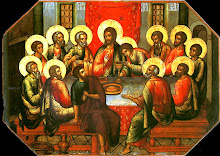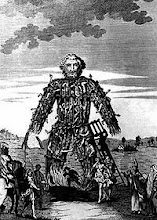Girard's mimetic theory posits an originary scene that pre-dates culture; meaning, there is not yet any "us". A prime tenet of mimetic theory is that humans are "mimetic" - contagiously imitative - as are all primates. That's why we "ape" one another. But to current western attitudes, we'd rather die than admit that we copy anybody. Since Rousseau, we endeavor even to hide this fact from ourselves; bbut if we are honest, we all have models. Madison Avenue knows it about us, however, quite well.
So, being mimetic before culture, Girard proposes the acquisitive gesture: somebody reaches for a delicacy - fruit, sexual partner, whatever - and others copy the desirous gesture. But there is a limited commodity. So, Hobbes's "war of all against all" kicks in.
When it looks as though all hell will break loose, the acquisitive gesture that was so contagious is replaced by a peace-making gesture: the ACCUSATORY gesture. Somebody (prior to language, a product of culture) points and says, 'All this is HIS fault," and this gesture is mimicked with lightning like rapidity.
The beginning of culture! WE suddenly all agree about something and we have a culprit. This is the lowest common denominator of culture: a victim we can all agree to expel and/or murder. Girard calls this, "unanimity minus one." The esprit de corp literally develops around the dead body of the one who is the agreed-upon wrong-doer.
This only brings us to the very beginning of culture. The crowd feels very good about itself after the murder, but also in Girard's estimation, very humbled. How could peace come about so abruptly, after chaos was so close? Clearly a god did it. Indeed, the victim who we thought caused the problem came to bring us peace by allowing us to kill him.
This is the beginning of a tripartite set of essentials for human culture: myth, ritual, and prohibition.
The myth is the story of how the god came in our time of distress, allowed us to kill him, and brought us peace and social harmony. Myth allows us to feel good, even "righteous", about our violence: the god caused it. We did the right thing in killing him; it is what he expected and wanted us to do.
The ritual is the beginning of what is religion, anthropologically speaking: religare - literally, a binding back, to the founding event of culture. It is the formalizing that originary founding violence in a ritual complete with priesthood to see that it is remembered correctly and efficaciously.
When things again become chaotic, socially and psychologically, the priesthood ratchets it up a few notches (release of violent prisoners, etc.), then the originally scene is played out again using a certifiable "bad guy" as victim. Caiaphus in John's Gospel says it well: "Better that one shd die than the whole nation be destroyed." The ritual re-establishes order, and, when done well, it is economic: only a single victim is sufficient.
Prohibition, the third element, is what keeps culture from getting too near flash-points that could ignite social chaos before the priesthood can contain things with ritual. Thus, conventional cultures always place taboos around murder, adultery, etc. - those things that can bring social solidarity to its knees.
These are all elements of traditional pagan culture, in Girard's understanding. Western civilization certainly contains such elements, but Girard discovered something in his studies, long after he developed a thorough-going theory: the Christian faith.
He didn't assume the truth of the gospel, he discovered it well after his studies took him, finally, to the New Testament and, thence, back to the Old. The biblical spirit is very much at-odds with the pagan spirit of what he calls "the primitive Sacred."
Part III - The effect of the Gospel on history, culture, and violence.








No comments:
Post a Comment